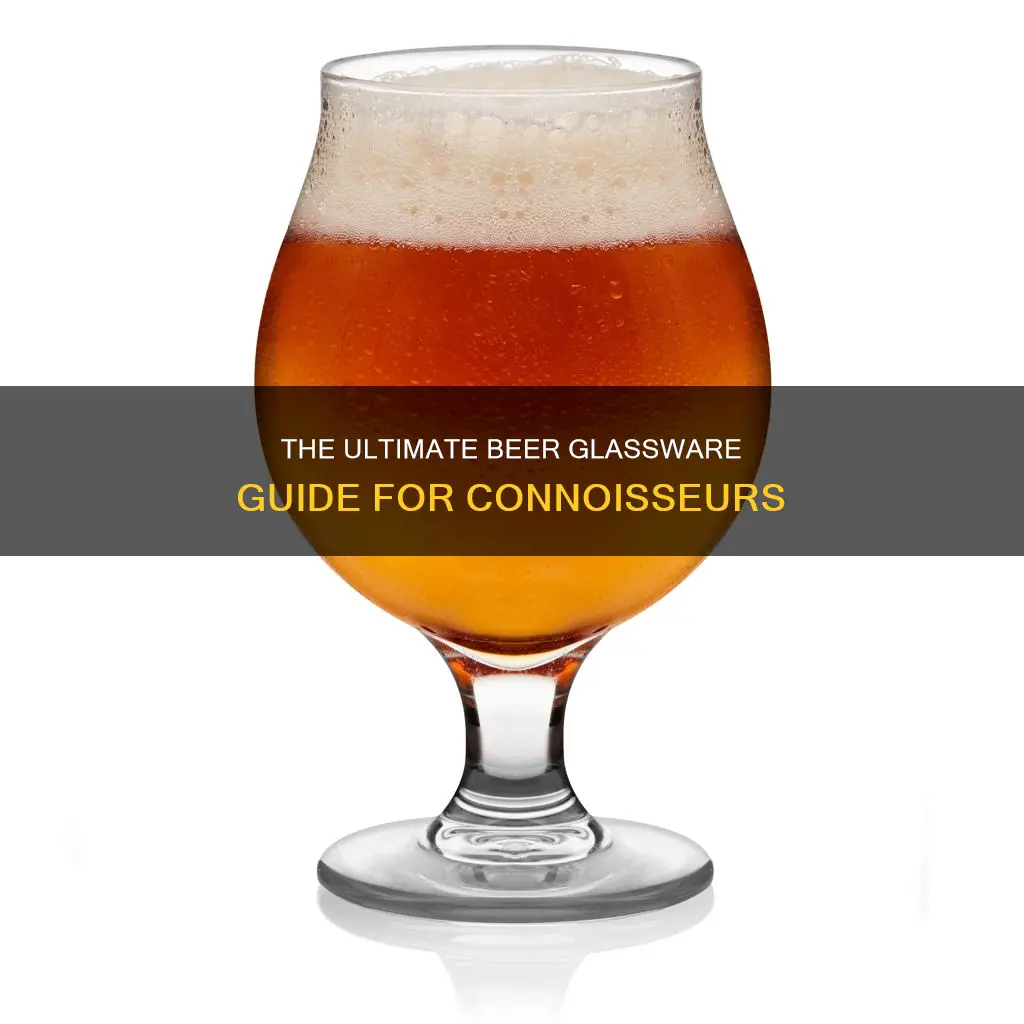
The type of vessel you drink beer from is a surprisingly contentious topic. While some people are content to drink straight from the can or bottle, others are of the opinion that the only way to drink beer is from a glass.
Beer snobs will tell you that the type of glass you use matters, and that each beer has an ideal glass that enhances its unique flavours, colours, and aromas. The shape of the glass can make a difference in the taste, aroma, and overall drinking experience of the beer. For example, the pilsner glass is ideal for lighter beers, while the Weizen glass is perfect for wheat beers.
However, others argue that the type of glass you drink beer from is irrelevant, and that the type of glass you use does not affect the taste of the beer.
Ultimately, the type of vessel you choose to drink beer from is a matter of personal preference. Whether you prefer to drink straight from the can, or to savour your beer in a fancy goblet, the most important thing is that you enjoy your drink.
| Characteristics | Values |
|---|---|
| Purpose | Enhance the beer's aroma, taste, colour, and overall drinking experience |
| Material | Glass, clay, pewter, stoneware, silver, porcelain, wood |
| Shape | Cylindrical, conical, curved, flared, trumpet-shaped, straight-sided, etc. |
| Volume | 2.5-20 ounces |
What You'll Learn

Beer Glasses Enhance Flavour
The glass you drink your beer from can significantly impact your drinking experience. While some people just grab any glass from the cupboard, beer aficionados know that each beer glass is designed to enhance a particular brew.
History of Beer Glasses
The earliest record of beer consumption dates back to 1800 B.C., when ancient Sumerians sipped their beer with a straw from clay pots. Beer glasses, however, didn't come into use until much later, after the advent of glass bottles. For a long time, people enjoyed their beer in pewter tankards, tall metal mugs often with hinged lids, which helped eliminate sediment from the beer.
Evolution of Beer Glasses
In the 1920s, the first handle-less and sloping-sided beer glass appeared on the market, eventually evolving into the 10-sided handled pint mug by the end of the decade. Over time, various types of beer glasses started appearing, each designed to enhance the flavour, colour, and aroma of different brews.
Types of Beer Glasses and Their Impact on Flavour
- Pint Glasses: The American pint glass, also known as the shaker glass, is simple and skinny, widening towards the top. It is commonly used for various beers, including lagers, ales, IPAs, stouts, and porters. The English pint glass, or Nonic glass, is similar but has a slight lip at the top and can hold more liquid. Pint glasses are ideal for uncarbonated beers served at room temperature.
- Beer Mugs: Beer mugs are robust, easy to use, and often come in various sizes. They have a wide cylindrical shape with a handle, and their thick glass walls help insulate the beer. The handle also prevents the beer from warming up. Some beer mugs have dimples, which some believe enhance the appreciation of the beer's colour.
- Beer Steins: Beer steins are similar to mugs but have a hinged lid and a lever for easy opening. They are traditionally made from various materials, including porcelain, stoneware, pewter, silver, and wood. Steins were once believed to be more sanitary and effective in preventing the bubonic plague.
- Goblets and Chalices: Goblets are larger and more extravagant, often with a medieval flair. They have a long, thick stem and a bowl on top, and they come in various sizes. Goblets and chalices are perfect for heavy, malty beers, such as Belgian ales and German Bocks, as their wide opening helps drinkers analyse the flavour profile and aromas.
- Pilsner Glass: The pilsner glass is tall, slender, and conical, ideal for lighter beers like pilsners. It showcases the beer's colour and carbonation and helps retain the foam head, enhancing the true flavour profile and aromas.
- Snifter: The snifter, often used for brandy or cognac, has a rounded bottom that increases heat transfer, slightly warming the beer. The inward-narrowing upper part enhances the aromatic quality of the liquid and allows for swirling, similar to a wine glass. Snifters are ideal for strong-flavoured beers.
- Weizen Glass: The Weizen glass is narrow at the bottom and slightly wider at the top, controlling the large amounts of foam typical of wheat beers. It helps trap the foam, enhancing the aroma and flavour associated with wheat beers.
- Tulip and Thistle Glasses: These glasses are designed to trap and maintain the foam head, enhancing the flavour and aromatics of hoppy and malty brews. They have a small stem and a unique, tulip-like bowl, with an outward-curving rim that aids in head retention.
- Willi Becher Glass: This traditional German-style glass flares out from the bottom and curves inward towards the top. It helps trap aromatics, and its versatility makes it suitable for various beer styles, from pilsners and bocks to witbiers and IPAs.
- Teku Glass: The Teku glass is a recent favourite among beer enthusiasts. This stemmed glass has a tapered conical shape and a lip that helps retain the beer's head. Its thin glass also keeps the beer colder for longer, making it suitable for any beer style.
Using the right beer glass can elevate your drinking experience by enhancing the flavour, colour, and aroma of your favourite brew. So, the next time you pour yourself a beer, consider choosing a glass that complements your drink and takes your enjoyment to the next level.
Beer then liquor, never been sicker: Safe drinking habits
You may want to see also

Drinking Beer Straight from the Bottle/Can
Drinking beer straight from the bottle or can is a common practice and it has been a topic of debate since canned beer was introduced in the 1930s. While some people prefer the convenience and portability of drinking beer straight from the container, there are both pros and cons to this approach.
One advantage of drinking beer straight from the bottle or can is the seal it provides, which helps keep the beer fresh and carbonated, especially for highly carbonated beers. Bottles and cans are also portable and perfect for on-the-go consumption or outdoor activities. They are easy to hold and fit comfortably in your hand, making them a popular choice for backyard barbecues and similar gatherings.
However, there are also some drawbacks to drinking beer straight from the bottle or can. One of the main disadvantages is that it limits your ability to appreciate the full aroma, flavour, colour, and clarity of the beer. The narrow opening of a bottle or can restricts airflow, which can impact the taste and aroma. Additionally, some people find that the metallic taste of the can affects the overall flavour of the beer.
Another factor to consider is the environmental impact. While bottles are more environmentally friendly, recyclable, and reusable, cans are often lighter and easier to transport, making them more convenient for certain situations. Ultimately, the decision to drink beer straight from the bottle or can comes down to personal preference, and there is no right or wrong way to enjoy a cold beer.
Golfers' Beer Consumption: How Much is Too Much?
You may want to see also

Beer Glasses for Different Brews
The glass you drink your beer from can make a big difference to your experience. While it may be tempting to just drink straight from the can, the right glass can enhance the flavour, aroma, and appearance of your beer.
History
The earliest record of beer consumption dates back to 1800 B.C., when ancient Sumerians sipped their beer with a straw from clay pots. Beer glasses only came along much later, after the advent of glass bottles. For a long time, people drank beer from pewter tankards, which often had hinged lids to prevent sediment from floating in the beer.
Types of Beer Glasses
There are many types of beer glasses, each designed to enhance the drinking experience of different brews. Here are some of the most common ones:
Pint Glasses
The American pint glass, also known as the shaker glass, is the most common type of beer glass in the United States. It has a simple, skinny cylindrical shape that widens at the top and typically holds 16 ounces of beer. This glass is suitable for most types of beer, including lagers, ales, IPAs, stouts, and porters.
The English pint glass, or Nonic glass, is similar to the American pint but features a slight lip at the top and can hold 20 ounces of liquid. It is often used for drinking English ales and lagers.
Beer Mugs and Steins
Beer mugs are common in England, Germany, and the United States. They are characterised by their wide cylindrical shape and handle, which helps keep the beer cool and prevents your hand from warming it up. Beer mugs may have a dimpled or smooth surface, with some believing that dimples help appreciate the colour of the beer.
Beer steins are very similar to mugs but feature a hinged lid and a lever for easy opening. Steins can be made from various materials, including glass, porcelain, wood, pewter, and silver. They were particularly popular in the 16th century as people believed the lids kept the beer sanitary and prevented the bubonic plague. Today, they are mostly sold as ornamental or souvenir glassware.
Goblets and Chalices
Goblets are larger and more extravagant than other beer glasses, often associated with medieval times. They are characterised by a long, thick stem and a bowl that sits on top. Chalices are another name for goblets, usually with thicker glass walls. These glasses are great for heavy, malty beers like Belgian ales and German Bocks, as the wide opening helps drinkers analyse the flavour profile and aromas.
Pilsner Glass
The pilsner glass is tall, slender, and conical, typically holding 12 ounces of liquid. It is designed for lighter beers like pilsners and is popular in both Europe and America due to its ability to showcase the colour, carbonation, and foam of the beer.
Snifter
The snifter is characterised by its rounded bottom, which increases heat transfer from the hand, slightly warming the beer. This type of glass is often used for brandy or cognac and is ideal for highly aromatic beers like IPAs, barleywines, or imperial stouts. The narrow upper part of the glass enhances the aromatic quality of the liquid and allows for swirling, similar to a brandy snifter.
Weizen Glass
The Weizen glass originates from Germany and is used for wheat beers. It is narrow at the bottom and slightly wider at the top, allowing for better control of the large amounts of foam typical of Weizen beers.
Other Glasses
Other types of beer glasses include the tulip glass, which is similar to the snifter but with a flared top to aid in head retention; the Willi Becher, a traditional German-style glass with a flared bottom and curved top that traps aromatics; and the Teku glass, a recent favourite among beer enthusiasts for its ability to keep beer colder for longer.
The type of glass you drink your beer from can significantly impact your experience. Each glass is designed to bring out the unique flavours, colours, and aromas of different brews. So, the next time you pour yourself a beer, make sure you're using the right glass to enhance your drinking experience!
Still Game's Beer Choice: What's Their Favorite Brew?
You may want to see also

Beer Glasses with Lids
Glass Cups with Lids and Straws
These glass cups typically come in sets of four and are ideal for drinking beer, iced coffee, cocktails, and more. They usually include bamboo lids, straws, and cleaning brushes, making them a practical and eco-friendly choice. The lids help to keep your drink at the desired temperature while also preventing spills.
Host Freeze Beer Glasses
For a unique option, consider Host Freeze beer glasses. These glasses have double-walled insulation and are freezeable, ensuring your beer stays cold for longer. The set typically comes with two black 16-ounce glasses, perfect for enjoying a frosty beverage.
Stanley Adventure Insulated Stacking Beer Pint Glass
If you're looking for a durable and rugged option, the Stanley Adventure Insulated Stacking Beer Pint Glass is a great choice. Made of stainless steel and double-walled, these glasses will keep your beer cold and are perfect for outdoor adventures or camping trips.
Vozoka Drinking Glasses
Vozoka offers a set of four 16-ounce iced coffee cups with bamboo lids and glass straws. Ideal for beer, cocktails, whiskey, or soda, these glasses are a stylish and functional choice. The bamboo lids add a natural touch to your drinking experience.
YOUKE OLA Pre-Drilled Beer Glass Can
For a creative DIY option, YOUKE OLA offers pre-drilled beer glass cans with rubber stoppers, bamboo lids, and glass straws. You can fill the glasses with snow globe glitter or other decorations to create a unique and personalised beer-drinking experience.
When choosing beer glasses with lids, consider the material, capacity, and design that best suit your needs and preferences. Enjoy your beer in style with these functional and innovative options!
Beer-Loving Americans: Which State Drinks the Most?
You may want to see also

Beer Glasses for Wheat Beers
Wheat beers, also known as Weizenbier, are best served in a Weizen glass. This type of glass is tall and curvaceous, with a strong, narrow base and a distinctive curve as it goes up. The curved lip at the top of the glass helps trap and encourage a thick foam head, allowing you to appreciate the full aroma and flavor that comes with wheat beers.
The Weizen glass is often confused with the pilsner glass due to their similar shape and size. However, the main difference is that the Weizen glass has more curvature, especially at the top of the glass. It is also much taller than a pint glass and usually holds at least half a liter of beer.
The Weizen glass is designed for and primarily used for wheat beers. It is a great choice for people who enjoy drinking wheat ales, dunkelweizen, hefeweizen, kristalweizen, and weizenbock.
When choosing a Weizen glass, look for one with a strong, narrow base and a distinctive curve. This will allow for a generous pour while still leaving room for the thick, fluffy head that wheat beers are known for. The curved lip at the top of the glass is also important, as it helps trap and encourage the foam head.
In addition to the Weizen glass, wheat beers can also be served in a goblet or chalice. These glasses are characterized by a long, thick stem and a bowl that sits atop the stem. They are often used for drinking heavy, malty beers such as Belgian ales and German Bocks.
Near Beer After Neuropathy: Is It Safe?
You may want to see also
Frequently asked questions
Drinking from a glass allows you to see the beer and enhances its aroma, which in turn improves the flavour.
It depends on the type of beer and your personal preference. The "right" glass will enhance the beer's aroma, taste, and appearance.
Here are some common types of beer glasses:
- Pint glasses (shaker pints)
- Beer mugs
- Beer steins
- Goblets and chalices
- Pilsner glasses
- Snifters
- Weizen glasses
- Tulip glasses
- Thistle glasses
- Stange glasses
Don't do it! Frosted glasses mute the flavour of the beer by robbing it of its volatile aromatics.
The earliest record of beer consumption dates back to 1800 B.C., when ancient Sumerians sipped beer through a straw from clay pots. Beer glasses were introduced much later, after the advent of glass bottles. For a long time, people drank beer from pewter tankards, which had hinged lids to eliminate sediment. In the 1920s, the first handle-less, sloping-sided beer glass appeared, eventually evolving into the 10-sided handled pint mug by the end of the decade.







